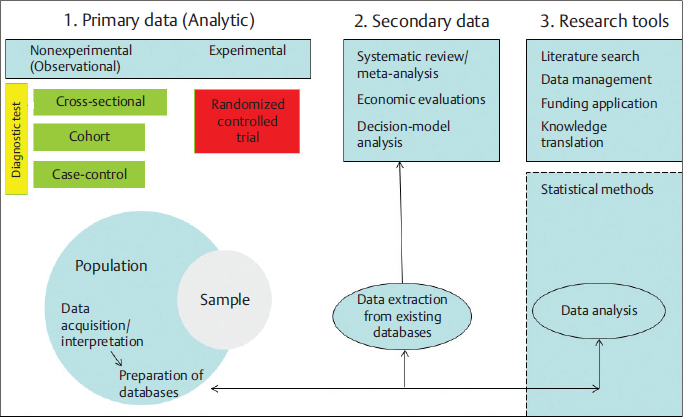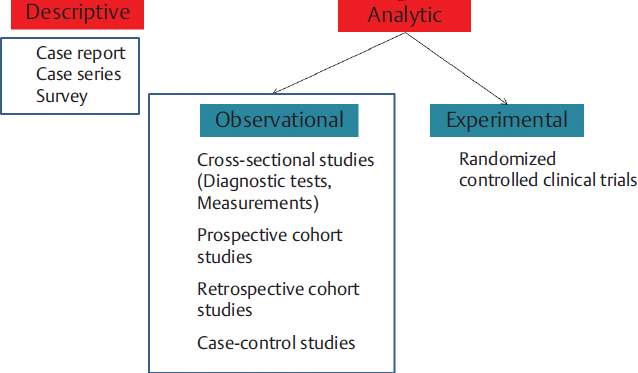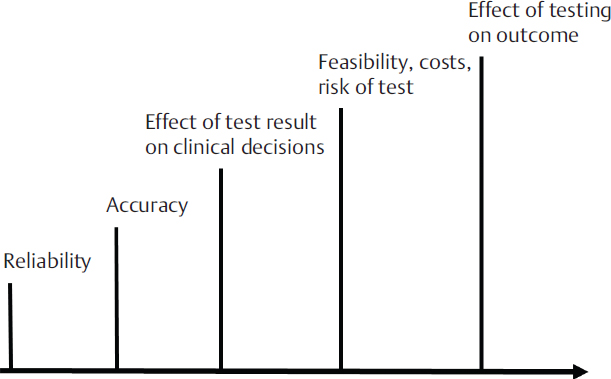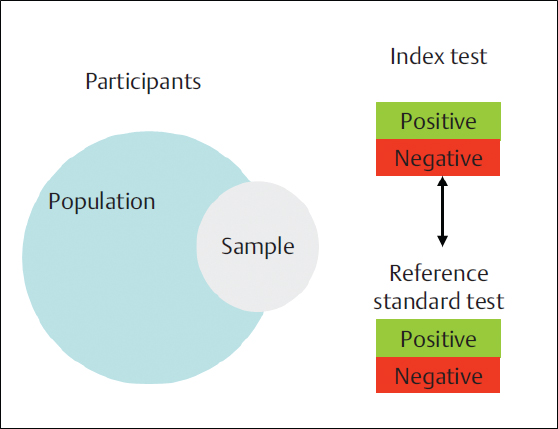1 • To provide an overview of available research designs in clinical research focusing on advantages and disadvantages of each type of design. • To recognize the differences among clinical research designs. • To identify the design of a study. • To understand the applications of each type of research design. • To choose an appropriate design to examine a given question. The fundamental goal of clinical research is to improve patient care. To do this, researchers attempt to learn the “truth” about the frequency of disease, etiology, prognosis, or therapy. There are two main categories of research design that can be used to obtain primary data and compare therapies: nonexperimental and experimental methods1 (Table 1.1). Within the broad spectrum of nonexperimental methods, we include observational designs. Specific observational designs include cross-sectional, cohort, and case-control studies. Table 1.1 PICO approach for formulating a research question
Overview of Research Designs Applied to Radiology
 Learning Objectives
Learning Objectives
 Introduction
Introduction
Feature of interest | Question |
Patients | Who are you asking the question about? |
Intervention | What intervention are you interested in? |
Control or comparison | What are you comparing the intervention with? |
Outcome | What outcome are you interested in measuring? |
Within the spectrum of experimental methods, randomized controlled trials (RCTs) represent the primary study category.
Primary or secondary data can be used to conduct a research study. Examples of studies that use secondary data include systematic reviews/meta-analyses, economic evaluations, and decision-model analyses, which are discussed in subsequent chapters along with tools and approaches (data management, knowledge translation, literature search) that are available to facilitate and standardize research methodology (Fig. 1.1). Whereas primary data research designs (the topic of this chapter) tend to investigate emerging technology, secondary data research designs (Chapters 7, 8, and 9) tend to use information available in the literature or databases on mature technology.
 Steps of a Research Project
Steps of a Research Project
The initial steps in planning a study include:
• Defining the research question, which should be novel, relevant, and feasible.
• Conducting a literature search to determine whether any other similar studies are already available in the literature and to set the stage for the methodology of the current study.
• Estimating the sample size to determine the feasibility of the study in your own center (single center) or the need for a multicenter study if the number of required subjects for the study bypasses the available number of patients with a given condition in your center.

Fig. 1.1 Summary of the content scope of this book including primary and secondary data research designs, and research tools that enable methodologic conduct, data analysis, and dissemination of the research results.
• Discussing the study budget and required infrastructure to determine the feasibility of the study.
• Defining the research design.
• Discussing the statistical analysis with a statistician.
This chapter considers different research designs that can be used to address questions related to the radiological field.
 Formulating a Research Question
Formulating a Research Question
Designing a proper study question to address an area of clinical uncertainty is the first step in any research initiative, and one way to focus your research is to use the PICO approach (people, patients, or population; intervention; control or comparison; and outcome).2 Table 1.1 shows the features of interest and corresponding questions of the PICO approach for formulating a research question.
Characteristics of a good research question are (FINER)1:
F: Feasible
N: Narrow in scope: “If you hit a bell with a pebble you will get a small sound. If you hit it with a mallet you will achieve a large sound.” One of the major mistakes of young investigators in conceiving a research question is to formulate questions that are broad in scope and ambitious in number of features to be addressed.
I: Interesting
N: Novel
E: Ethical
R: Relevant
Typically, a strong research project has one primary research question and no more than three (or four) secondary questions. A correctly formulated research question should result in a “yes/no” answer.
Investigators can use descriptive or analytic research designs to conduct their research using primary data (Fig. 1.2). Nonexperimental (observational) and experimental research designs fall within the analytic category of designs.
 Nonexperimental (Observational) Research
Nonexperimental (Observational) Research
Diagnostic Test Design
Diagnostic tests measure and classify clinical phenomena in the context of accepted knowledge on nosology. This process will include or exclude a certain disease, select a disease from a set of candidate diseases, or establish the presence of several diseases. The goal of the diagnostic process is to improve patient care and clinical outcomes.
Diagnostic tests not only provide information about the likelihood of a particular diagnosis, but also determine the next step in the management of an individual who is being tested. It is thus important that diagnostic tests are accurate. Accuracy is the ability of a test to differentiate between patients who have the condition of interest (target condition) and those who do not. The accuracy of a test is studied by comparing the results of the test under investigation (index test) with the results of a reference standard on the same participants.3 The reference standard (also referred to as “gold standard”) is the best available method to establish the presence or absence of the target condition. Often the reference standard is a test that, compared to the index test, is more expensive (magnetic resonance imaging [MRI], reference standard vs. ultrasound, index test), potentially more harmful (computed tomography [CT], reference standard vs. radiography, index test), more invasive (biopsy, reference standard vs. MRI, index test), or requires more logistical efforts (diagnostic expert panel).
In evaluating diagnostic tests, several study designs can be applied, depending on the stage of evaluation of a diagnostic test and the research question.4 The basic stage in the evaluation of a diagnostic test is concerned with test properties (Fig. 1.3). Test properties tell us how well the test can discriminate between healthy and diseased individuals. The essential property of any diagnostic test is reliability. A test is regarded as reliable if the same result is obtained when the test is repeated by the same (intra-rater or test-retest reliability) or different (inter-rater reliability) investigators (or technologies).5 Reliability is the prerequisite for validity, which is the degree of closeness of measurements of a quantity to that quantity’s true value. Validity in diagnostic test research tells us if the conclusion of the test is actually true. The term accuracy, typically used in diagnostic test research, encompasses both reliability and validity. An accurate test is one that has demonstrated reliability and validity. In evaluating the accuracy of a diagnostic test, the cross-sectional study design is commonly employed. Alternatives are cohort studies but also case-control studies. Once the diagnostic accuracy is established, other stages in evaluating the test should be explored to understand the relevance of the test in terms of clinical outcomes.6 These include understanding how a particular test affects the diagnostic workup in general; how a test affects the choice of several treatment options; and to what degree having a test improves patient outcomes such as quality of life or life expectancy. Diagnostic tests can be embedded into specific observational designs, as we discuss in the following sections of this chapter.
Cross-Sectional Design
A cross-sectional study takes place at one point (cross-section) in time. The researcher identifies a sample (study participants) from a population of interest. All study maneuvers are carried out at one point in time: disease and exposure are measured simultaneously1 (Fig. 1.4). This is perhaps the most commonly used design in establishing the basic properties of a diagnostic test: reliability and validity. During evaluation, we determine how well a novel diagnostic test (index test) performs by comparing its results against an established test (reference standard). The results from the two tests are compared at one point in time (cross-section), and statistical measures of diagnostic accuracy of the index test are calculated.
Example: In infants who undergo operative treatment to reduce a dislocated hip, we want to determine whether ultrasound is a good enough diagnostic tool in determining the position of the femoral head in the acetabulum, which indicates a successful operation. MRI can visualize the infant hip and can provide this information with a high degree of accuracy. However, MRI is expensive, warrants sedation of the patient, and is not easily available. In conducting the study, we include all infants who undergo the operation in a certain period. Each infant obtains, according to a standardized protocol, ultrasound and MRI tests in a consecutive sequence at the same time. When all patients have been included, we compare if the ultrasound results provided the same information as MRI about the location of the femoral head. That is, we are interested if ultrasound is as accurate as MRI in determining the position of the femoral head in the acetabulum after the operation.
Stay updated, free articles. Join our Telegram channel

Full access? Get Clinical Tree





